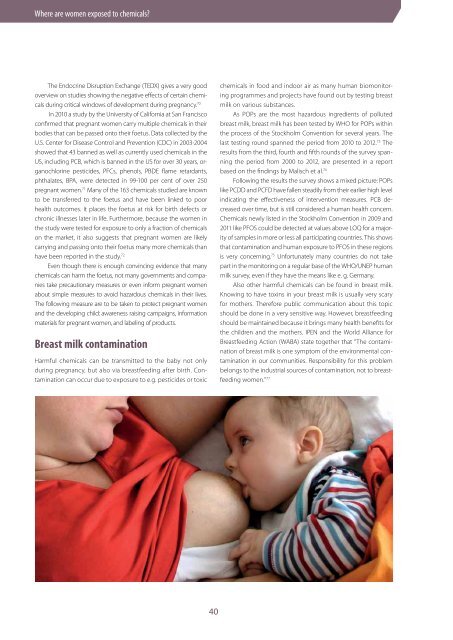Women and Chemicals
1ToENNR
1ToENNR
Create successful ePaper yourself
Turn your PDF publications into a flip-book with our unique Google optimized e-Paper software.
Where are women exposed to chemicals?<br />
The Endocrine Disruption Exchange (TEDX) gives a very good<br />
overview on studies showing the negative effects of certain chemicals<br />
during critical windows of development during pregnancy. 70<br />
In 2010 a study by the University of California at San Francisco<br />
confirmed that pregnant women carry multiple chemicals in their<br />
bodies that can be passed onto their foetus. Data collected by the<br />
U.S. Center for Disease Control <strong>and</strong> Prevention (CDC) in 2003-2004<br />
showed that 43 banned as well as currently used chemicals in the<br />
US, including PCB, which is banned in the US for over 30 years, organochlorine<br />
pesticides, PFCs, phenols, PBDE flame retardants,<br />
phthalates, BPA, were detected in 99-100 per cent of over 250<br />
pregnant women. 71 Many of the 163 chemicals studied are known<br />
to be transferred to the foetus <strong>and</strong> have been linked to poor<br />
health outcomes. It places the foetus at risk for birth defects or<br />
chronic illnesses later in life. Furthermore, because the women in<br />
the study were tested for exposure to only a fraction of chemicals<br />
on the market, it also suggests that pregnant women are likely<br />
carrying <strong>and</strong> passing onto their foetus many more chemicals than<br />
have been reported in the study. 72<br />
Even though there is enough convincing evidence that many<br />
chemicals can harm the foetus, not many governments <strong>and</strong> companies<br />
take precautionary measures or even inform pregnant women<br />
about simple measures to avoid hazardous chemicals in their lives.<br />
The following measure are to be taken to protect pregnant women<br />
<strong>and</strong> the developing child: awareness raising campaigns, information<br />
materials for pregnant women, <strong>and</strong> labeling of products.<br />
Breast milk contamination<br />
Harmful chemicals can be transmitted to the baby not only<br />
during pregnancy, but also via breastfeeding after birth. Contamination<br />
can occur due to exposure to e.g. pesticides or toxic<br />
chemicals in food <strong>and</strong> indoor air as many human biomonitoring<br />
programmes <strong>and</strong> projects have found out by testing breast<br />
milk on various substances.<br />
As POPs are the most hazardous ingredients of polluted<br />
breast milk, breast milk has been tested by WHO for POPs within<br />
the process of the Stockholm Convention for several years. The<br />
last testing round spanned the period from 2010 to 2012. 73 The<br />
results from the third, fourth <strong>and</strong> fifth rounds of the survey spanning<br />
the period from 2000 to 2012, are presented in a report<br />
based on the findings by Malisch et al. 74<br />
Following the results the survey shows a mixed picture: POPs<br />
like PCDD <strong>and</strong> PCFD have fallen steadily from their earlier high level<br />
indicating the effectiveness of intervention measures. PCB decreased<br />
over time, but is still considered a human health concern.<br />
<strong>Chemicals</strong> newly listed in the Stockholm Convention in 2009 <strong>and</strong><br />
2011 like PFOS could be detected at values above LOQ for a majority<br />
of samples in more or less all participating countries. This shows<br />
that contamination <strong>and</strong> human exposure to PFOS in these regions<br />
is very concerning. 75 Unfortunately many countries do not take<br />
part in the monitoring on a regular base of the WHO/UNEP human<br />
milk survey, even if they have the means like e. g. Germany.<br />
Also other harmful chemicals can be found in breast milk.<br />
Knowing to have toxins in your breast milk is usually very scary<br />
for mothers. Therefore public communication about this topic<br />
should be done in a very sensitive way. However, breastfeeding<br />
should be maintained because it brings many health benefits for<br />
the children <strong>and</strong> the mothers. IPEN <strong>and</strong> the World Alliance for<br />
Breastfeeding Action (WABA) state together that “The contamination<br />
of breast milk is one symptom of the environmental contamination<br />
in our communities. Responsibility for this problem<br />
belongs to the industrial sources of contamination, not to breastfeeding<br />
women.” 77<br />
40


